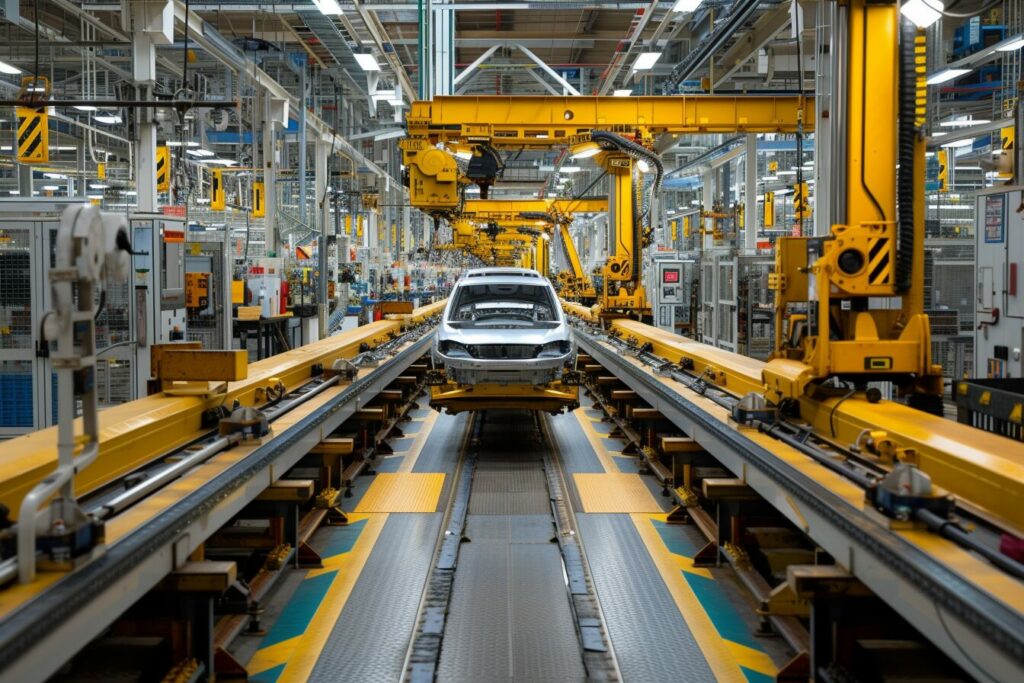
The past few years have been chaotic for the manufacturing sector. From the pandemic, to Brexit, cost of living, and war in Europe and the Middle East, it seems as though the manufacturing sector cannot catch a break.
There remains a question which all manufacturing executives are asking themselves: will next year be better?
The same question was proposed to manufacturers in a survey to gage what topics are on their minds and their confidence in the sector moving into 2024. Make UK, in collaboration with PwC, released its Executive Survey 2024 report deep diving into what executives think, risks, opportunities and an outlook for this 2024.
On the whole, there is a sense of “cautious optimism” amongst executives. Many are aware of the risks that will be brought forward from 2023 to 2024 but remain confident that a new rise in opportunities will help combat some of the challenges to come.
To summarise 2023, the UK sat as the 8th largest manufacturing economy by value of output. The sector accounted for 10% of UK GDP and 49% of the UK’s total exported goods. In terms of labour, the sector provided 2.6m jobs and it paid 9% higher wages than the wider UK average.
In the Autumn Statement, policy announcements such as permanent full expensing, the rollout of the Made Smarter programme and a fund to increase engineering apprenticeships, provided comfort after facing turbulent economic shocks since the pandemic.

Moving to 2024, it is a matter of whether manufacturers want to hear the good news or bad news first. We will cover the bad news, or rather risks going into 2024, first. Three of the major risks manufacturers anticipate in 2024 are costs, access to labour and skills, and instability and disruption.
First, cost is a risk that cannot be ignored. Energy prices remain the biggest risk for growth in this sector, despite falling from their peak in 2022. 68% of companies are expecting energy costs to increase either significantly or moderately. Additionally, input costs, such as parts, equipment, labour, and import/export fees remain another point of concern.
90% of companies are expecting a spike in employment-related costs. The planned increase in National Living Wage of 9.4% in the spring, plus the lowering of the age threshold from 23 to 21, will increase costs for employers throughout the entire workforce. A labour shortage (covered further down) is also driving higher pay, in combination with higher training costs for unskilled workers.
Import and export costs will worsen for more than 60% of manufacturers in the next 12 months. According to the report:
“Manufacturers have been dealing with new administrative costs for trading with the EU and an uncertain trading environment, impacting their competitiveness abroad. Some 90% of manufactures say the Trade Cooperation Agreement (TCA) resulted in challenges to trade when trading with the EU.”
And the UK has done little to reduce barriers to non-EU countries; these barriers increase access to logistics, such as shipping, rail, and air. As manufacturers sit in the middle of the value chain, transport costs will impact these businesses disproportionately, affecting the bottom line of these businesses. According to the report:
“Make UK research indicates that as inflation cools, profit margins have been recovering at a snail’s pace, with the majority of manufacturers reporting declining margins on balance quarter on quarter. In addition, costs associated with the UK’s full exit from the EU remain on the risk register, with more than one in five manufacturers (22%) citing increased costs to meeting EU regulations, such as REACH, as a risk to growth.”
The second major risk facing this sector is access to people and skills. There were 69,000 live vacancies in the sector in November 2023, peaking at around 95,000 in May 2022. According to the report: “While this might look like a significant improvement, pre-pandemic in February 2020 there were just 1.6 unfilled vacancies for every 100, and yet this figure now appears stalled at 2.8.”
There is no easy solution to the labour shortage for this sector. Recruiting job overseas is not much of an option for manufacturers, particularly since recruiting from the EU is now more complex with a points-based system. Additionally, from spring 2024 onwards, the government plans to increase the minimum salary for overseas workers, causing another complication for manufacturers to use overseas labour to fill labour shortages.
Not only is there a labour shortage, but manufacturers are also facing a skills gap. The missing gap for manufactures are IT/digital skills and line management and people skills: “A third of companies cite skills as a barrier to growth in the year ahead. Even if they can get a good number of applicants, the skills don’t always follow. As a result, there are more plans to train domestic employees and ensure they are equipped with the right skills for the future.”
At Polestar, we have seen considerable interest in those companies that have built inhouse development processes and training academies to develop staff and augment specialist expertise to differentiate themselves from the market. We would expect this theme to continue.

Third, instability and disruption, both domestic and abroad, will affect manufacturing this coming year. Domestically, the likelihood of a General Election in 2024 is uneasy for the sector. Lots of policies were passed that enhanced this sector, executives question whether those will be followed through if there is a change in the UK Government.
Abroad, recent instability in the Middle East and Eastern Europe could cause supply chain issues. Trading challenges with the EU continue after Brexit, and competition with the US after the Inflation Reduction Act maybe hamper trading relations across the Atlantic.
These concerns around cost, labour and instability are issues that should be familiar from our sector reports. These challenges are not too different from other sectors that are also facing ramifications for inflation and macroeconomic volatility. The healthcare sector is having challenges with recruiting workers for hospitals and care centres. Additionally, increase in wages and training costs for healthcare workers are also eating into the margins of healthcare companies. The sustainability sector relies on heavy regulation, impacted by instability and disruption from legislation. Business Services also relies on efficient supply chain management and reliable energy prices, particularly for the logistics subsector.
Whilst there is some comfort in knowing that all sectors have been facing issues in one way or another, executives will need to be mindful of these risks while looking to the future for new opportunities.
Now that the bad news is covered, we move to the good. Manufacturers are keen to turn some of the risks for 2024 into opportunities, such as: product portfolios enhancement, net zero, increasing global competitiveness, and digitiatisation.
The first opportunity manufacturers are excited about is expanding their product portfolios. Innovation and revolutionising products has never been as important as it is today in our modern, technological world. By using new tech, such as AI, machine learning, and IoT, there are many opportunities to enhance efficiency and create new products and services.
The second opportunity is achieving net zero, a solution for many manufacturers arising from the problem of increased energy prices. According to the report:
“Net zero investments, most of which have been energy efficiency investments, have been bolstering the UK manufacturing’s business investment volumes, and will continue to do so. With wider economic metrics for the sector seeing a downturn towards the end of 2023, investment intentions have avoided some of this negativity as the sector accelerates plans to minimise energy use. In the short term, this mobilisation has been driven by heightened energy costs, but the improvements from energy efficient technologies being invested in by the sector will deliver benefits far beyond cost minimisation in the long-run”

The third opportunity has been expanding globally. Manufacturers have their eyes set on tapping into new geographies: since leaving the EU, the UK has signed several new trade agreements which can bolster the manufacturing sector. Australia and New Zealand are two landmark post-Brexit free trade agreements, signed on December 2021 and February 2022 respectively. These deals were negotiated from scratch, in theory allowing the UK to tailor them as per its objectives.
Recently, we saw the signing of the UK/Comprehensive and Progressive Agreement for Trans-Pacific Partnerships signed in 2023, an Asia-Pacific trade bloc of 11 countries. A UK-India trade deal has been in talks since early 2022.
The UK is currently renegotiating terms with Canada, Mexico, Israel, and Ukraine, with the ambition of securing agreements that are more aligned with the UK’s priorities.
The UK is also currently negotiating several trade deals from scratch, including with India and the Gulf Cooperation Council (GCC), made up of Bahrain, Kuwait, Oman, Qatar, Saudi Arabia, and the United Arab Emirates, while also looking to join the CPTPP.
Whilst going global is a goal, the EU remains a top choice for manufacturers, citing geographical proximity and cultural similarities. It is imperative to this sector that trade relations are renewed with the UK’s largest trading partner.
The fourth opportunity is one that ties all the others together: digitisation. Being the birthplace of the Industrial Revolution in the 18th century, the UK is no stranger to industrial changes. With the start of Industry 4.0, the question lies in whether the UK is prepared to lead this modern revolution as well. The UK government has implemented schemes to increase digital capabilities across the UK economy in the modern Industrial Strategy. Artificial Intelligence (AI) is thought by the government to be one area where the UK could lead the world, as demonstrated by its £900m investment into the building of a new supercomputer to handle large language models (“LLMs”), as well as hosting the world’s first global summit on AI and its safety/handling.
Investing in advanced technologies such as robotics, cloud, data analytics, AI and machine learning can improve the competitiveness of manufacturers. With digitisation, “developing new or improved methods of manufacturing; increasing energy efficiency for the business; producing sustainable products; and delivery services. Such improvements can lead to increased efficiency, better quality and reduced costs, which, in turn, can increase productivity and resilience while also reducing their carbon footprint.”
A great way the government can help the UK rise to the top is to invest heavily into smaller manufacturing companies, such as family-owned business. The larger UK manufacturing businesses will reinvest in their own technology to make them more competitive both domestically and internationally; it is the smaller companies that will need the most focus.
Smaller companies need to be more aware of the schemes that are put in place that can help make them improve in the new Industry 4.0 world. If you are a smaller manufacturing company, MAKEUK has a list of schemes available for companies to take advantage of the situation they are in now.
Long-term growth across the sector will be linked to the continuing digital transformation such as smart factories offering the introduction of efficient and predictive processes. The scale-up of in-house production lines, robotics, automation platforms, and AI-enabled services will transform market participants, creating breathing room in the already high levels of demand.

To summarise, there are going to be positives and negatives going into 2024. Canny manufacturers will leverage these positive trends to offset the bad ones. Investing in new technology can enhance portfolios and increase efficiency, reducing costs and increase competitiveness not just domestically but also overseas. Additionally, this advancement can also help reduce labour shortages, relying on more machine labour than human labour that we cannot fill gaps for. Manufacturers will have to get creative and take advantage of technology that is in front of them to ease their worries about 2024.
This sector has shown resilience even throughout the most chaotic of times, something investors are keen to take advantage of. If you want to get in touch about anything manufacturing related, don’t hesitate to do so. With the current levels of demand in this space, this could be a good time to explore your options for raising funding or securing a valuable exit.
Like always, if you have any interest, please reach out!